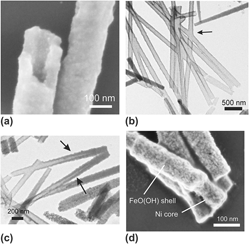Crossref Citations
This article has been cited by the following publications. This list is generated based on data provided by
Crossref.
George, Antony
Maijenburg, A. Wouter
Nguyen, Minh Duc
Maas, Michiel G.
Blank, Dave H. A.
and
ten Elshof, Johan E.
2011.
Nanopatterning of Functional Materials by Gas Phase Pattern Deposition of Self-Assembled Molecular Thin Films in Combination with Electrodeposition.
Langmuir,
Vol. 27,
Issue. 20,
p.
12760.
George, Antony
Maijenburg, A. Wouter
Maas, Michiel G.
Blank, Dave H. A.
and
ten Elshof, Johan E.
2011.
Electrodeposition in Capillaries: Bottom-up Micro- and Nanopatterning of Functional Materials on Conductive Substrates.
ACS Applied Materials & Interfaces,
Vol. 3,
Issue. 9,
p.
3666.
George, Antony
Maijenburg, A. Wouter
Maas, Michiel G.
Blank, Dave H. A.
and
ten Elshof, Johan E.
2011.
Patterning Functional Materials Using Channel Diffused Plasma-Etched Self-Assembled Monolayer Templates.
Langmuir,
Vol. 27,
Issue. 19,
p.
12235.
Maijenburg, A. Wouter
George, Antony
Samal, D.
Nijland, Maarten
Besselink, Rogier
Kuiper, Bouwe
Kleibeuker, Josée E.
and
ten Elshof, Johan E.
2012.
Electrodeposition of micropatterned Ni|Pt multilayers and segmented Ni|Pt|Ni nanowires.
Electrochimica Acta,
Vol. 81,
Issue. ,
p.
123.
Pondman, Kirsten M.
Maijenburg, A. Wouter
Celikkol, F. Burcu
Pathan, Ansar A.
Kishore, Uday
Haken, Bennie ten
and
ten Elshof, Johan E.
2013.
Au coated Ni nanowires with tuneable dimensions for biomedical applications.
Journal of Materials Chemistry B,
Vol. 1,
Issue. 44,
p.
6129.
Petrii, O A
2015.
Electrosynthesis of nanostructures and nanomaterials.
Russian Chemical Reviews,
Vol. 84,
Issue. 2,
p.
159.
Pérez-Page, María
Yu, Erick
Li, Jun
Rahman, Masoud
Dryden, Daniel M.
Vidu, Ruxandra
and
Stroeve, Pieter
2016.
Template-based syntheses for shape controlled nanostructures.
Advances in Colloid and Interface Science,
Vol. 234,
Issue. ,
p.
51.
Movsesyan, Liana
Maijenburg, Albert Wouter
Goethals, Noel
Sigle, Wilfried
Spende, Anne
Yang, Florent
Kaiser, Bernhard
Jaegermann, Wolfram
Park, Sun-Young
Mul, Guido
Trautmann, Christina
and
Toimil-Molares, Maria Eugenia
2018.
ZnO Nanowire Networks as Photoanode Model Systems for Photoelectrochemical Applications.
Nanomaterials,
Vol. 8,
Issue. 9,
p.
693.
Dauletbekova, Alma
Vlasukova, Liudmila
Baimukhanov, Zein
Akilbekov, Abdirash
Kozlovskyi, Artem
Giniyatova, Sholpan
Seitbayev, Aibek
Usseinov, Abai
and
Akylbekova, Aiman
2019.
Synthesis of ZnO Nanocrystals in SiO2/Si Track Template: Effect of Electrodeposition Parameters on Structure.
physica status solidi (b),
Vol. 256,
Issue. 5,
Manzano, Cristina V.
Philippe, Laetitia
and
Serrà, Albert
2022.
Recent progress in the electrochemical deposition of ZnO nanowires: synthesis approaches and applications.
Critical Reviews in Solid State and Materials Sciences,
Vol. 47,
Issue. 5,
p.
772.
Leontiev, A. P.
Bograchev, D. A.
Khmelenin, D. N.
Tsirlina, G. A.
and
Napolskii, K. S.
2024.
Evolution of morphology and grain structure of metal nanowires in initial period of templated electrodeposition.
Journal of Solid State Electrochemistry,
Vol. 28,
Issue. 5,
p.
1619.
